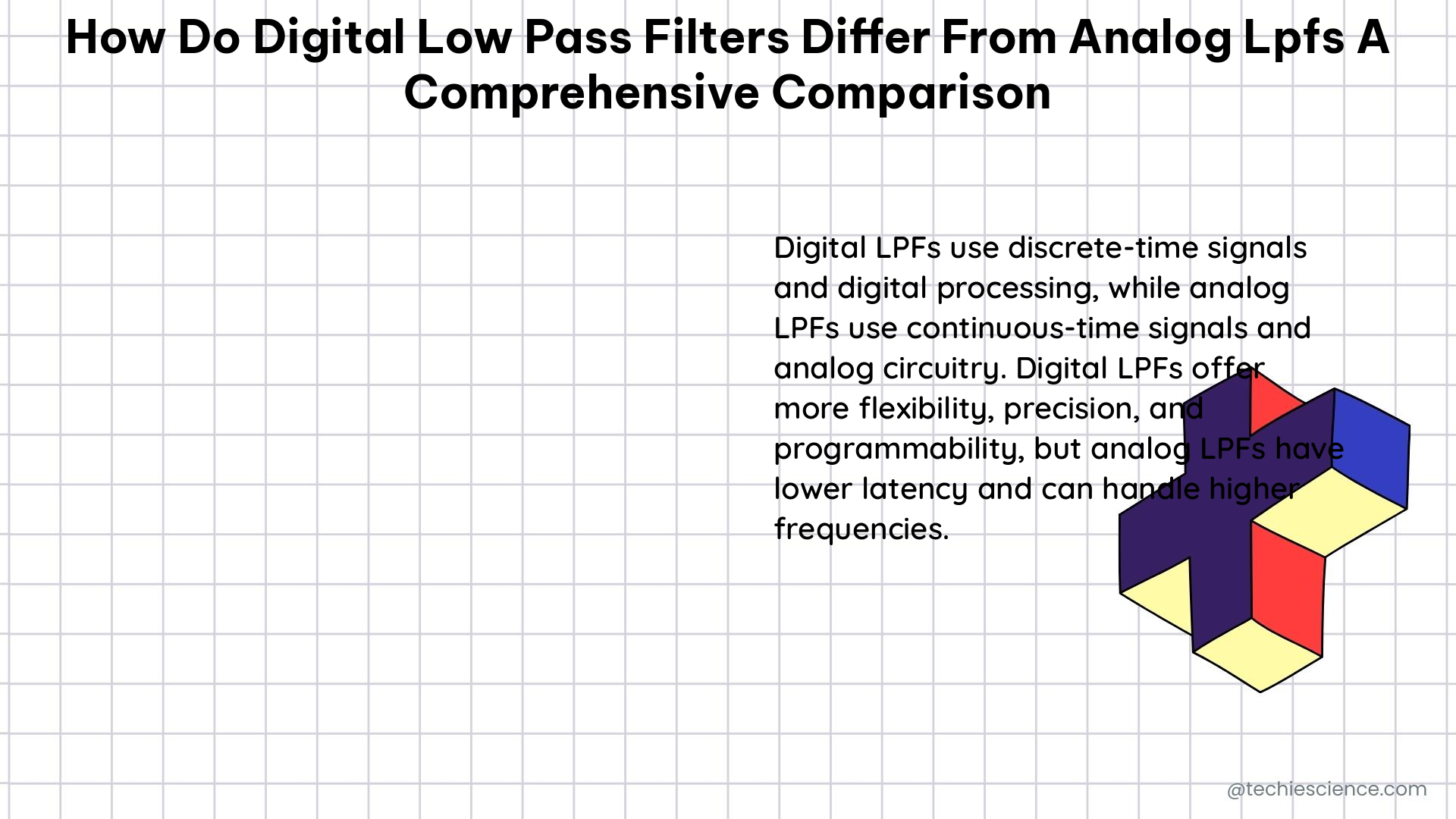Digital Low Pass Filters (DLPFs) and Analog Low Pass Filters (ALPFs) are two distinct approaches to filtering signals, each with its own advantages and disadvantages. This comprehensive comparison will delve into the technical details, quantifiable data, and specific differences between these two filter types.
Implementation: Digital vs. Analog Approach
Digital Low Pass Filters (DLPFs):
– Implemented using digital signal processing techniques, involving mathematical operations on discrete-time signals.
– Typically realized using digital signal processors (DSPs), microcontrollers, or field-programmable gate arrays (FPGAs).
– The filter algorithm is executed on a digital platform, allowing for flexible and programmable filter designs.
Analog Low Pass Filters (ALPFs):
– Implemented using electronic components, such as resistors, capacitors, and operational amplifiers.
– The filter is realized using an analog circuit, where the signal is processed in the continuous-time domain.
– The filter characteristics are determined by the physical properties and interconnections of the electronic components.
Flexibility: Adaptability and Customization

Digital Low Pass Filters (DLPFs):
– Offer greater flexibility in design, allowing for the implementation of various filter types, such as Finite Impulse Response (FIR), Infinite Impulse Response (IIR), and Cascaded Integrator-Comb (CIC) filters.
– Filter coefficients can be easily modified, enabling dynamic adjustment of the filter’s characteristics.
– Digital filters can be designed and implemented using software, providing a high degree of customization and adaptability.
Analog Low Pass Filters (ALPFs):
– Have limited design flexibility, as they are constrained by the characteristics of the electronic components used in their implementation.
– Modifying the filter characteristics often requires physical changes to the circuit, such as replacing components or altering the circuit topology.
– Analog filter design is typically more challenging and time-consuming, as it involves the selection and interconnection of specific electronic components.
Cost: Implementation and Maintenance
Digital Low Pass Filters (DLPFs):
– Generally have lower implementation costs, as they can be designed using software and off-the-shelf digital signal processors (DSPs) or microcontrollers.
– The cost of digital filter implementation is primarily driven by the cost of the digital hardware, which has been steadily decreasing over time due to advancements in semiconductor technology.
– Maintenance and updates to digital filters can be easily performed through software modifications, reducing the overall cost of ownership.
Analog Low Pass Filters (ALPFs):
– Require specialized electronic components, such as high-precision resistors, capacitors, and operational amplifiers, which can be more expensive, especially for high-performance filters.
– The implementation of analog filters often involves custom circuit design and manual tuning, which can increase the overall cost of development and production.
– Maintenance and modifications to analog filters typically involve physical changes to the circuit, which can be more time-consuming and costly compared to digital filter updates.
Performance Specifications: Frequency Response, Group Delay, and Dynamic Range
Frequency Response:
– Digital Low Pass Filters (DLPFs): Can achieve near-perfect frequency responses, limited mainly by round-off errors and the finite word length of the digital representation.
– Analog Low Pass Filters (ALPFs): Are subject to component tolerances and non-idealities, leading to deviations from the desired frequency response, such as passband ripple and stopband attenuation.
Group Delay:
– Digital Low Pass Filters (DLPFs): Can provide linear phase response, ensuring a constant group delay across the passband.
– Analog Low Pass Filters (ALPFs): Typically have nonlinear phase response, leading to varying group delays, which can cause distortion in the time domain.
Time-Domain Response:
– Digital Low Pass Filters (DLPFs): Can exhibit better transient response, with less overshoot and ringing, compared to analog filters.
– Analog Low Pass Filters (ALPFs): May have more pronounced transient response characteristics, such as overshoot and ringing, due to the inherent properties of the analog circuit components.
Speed:
– Analog Low Pass Filters (ALPFs): Are generally faster, as they do not require data conversion or digital processing.
– Digital Low Pass Filters (DLPFs): Can be limited by the speed of the DSP or microcontroller used in their implementation, which may introduce additional latency.
Dynamic Range:
– Analog Low Pass Filters (ALPFs): Offer higher amplitude dynamic range, limited mainly by the noise floor of the electronic components used in their implementation.
– Digital Low Pass Filters (DLPFs): Are limited by the resolution and noise floor of the analog-to-digital converter (ADC) used in their input stage, as well as the finite word length of the digital representation.
Examples and Numerical Problems
Digital Low Pass Filter (DLPF) Example:
A simple IIR digital low pass filter can be implemented as:
out = (1-a) * in + a * out
where ‘a’ controls the cutoff frequency. For a 5 Hz cutoff frequency and a 1 MHz sample rate, the value of ‘a’ can be calculated as:
a = exp(-2*pi*5/1E6) = 0.99997
Analog Low Pass Filter (ALPF) Example:
A simple passive RC low pass filter can be implemented as:
R1 || (R2 + 1/(s*C))
where R1 and R2 are resistors, C is a capacitor, and s is the complex frequency variable. For a 5 Hz cutoff frequency, the value of CR can be calculated as:
CR = 1/(5*2*pi) = 0.03183
By understanding the specific implementation details, flexibility, cost, and performance characteristics of digital and analog low pass filters, engineers can make informed decisions on the most suitable filter type for their application requirements.
References:
- Time Delay: Digital Low Pass Filter vs Analog Low Pass Filter
- Analog vs. Digital Filters
- Chapter 21: Digital Filters

The lambdageeks.com Core SME Team is a group of experienced subject matter experts from diverse scientific and technical fields including Physics, Chemistry, Technology,Electronics & Electrical Engineering, Automotive, Mechanical Engineering. Our team collaborates to create high-quality, well-researched articles on a wide range of science and technology topics for the lambdageeks.com website.
All Our Senior SME are having more than 7 Years of experience in the respective fields . They are either Working Industry Professionals or assocaited With different Universities. Refer Our Authors Page to get to know About our Core SMEs.